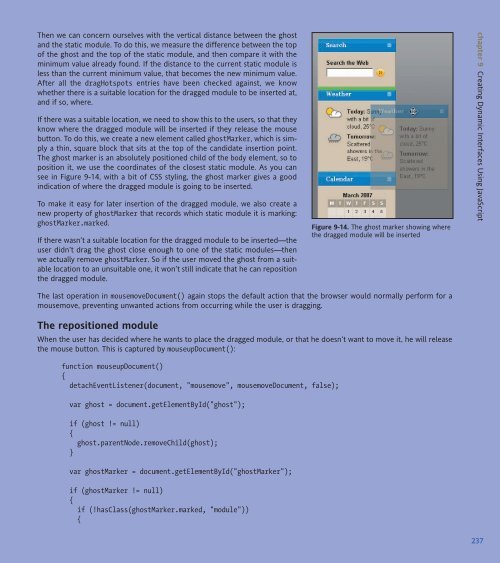WEB STANDARDS CREATIVITY
WEB STANDARDS CREATIVITY
WEB STANDARDS CREATIVITY
Create successful ePaper yourself
Turn your PDF publications into a flip-book with our unique Google optimized e-Paper software.
Then we can concern ourselves with the vertical distance between the ghost<br />
and the static module. To do this, we measure the difference between the top<br />
of the ghost and the top of the static module, and then compare it with the<br />
minimum value already found. If the distance to the current static module is<br />
less than the current minimum value, that becomes the new minimum value.<br />
After all the dragHotspots entries have been checked against, we know<br />
whether there is a suitable location for the dragged module to be inserted at,<br />
and if so, where.<br />
If there was a suitable location, we need to show this to the users, so that they<br />
know where the dragged module will be inserted if they release the mouse<br />
button. To do this, we create a new element called ghostMarker, which is simply<br />
a thin, square block that sits at the top of the candidate insertion point.<br />
The ghost marker is an absolutely positioned child of the body element, so to<br />
position it, we use the coordinates of the closest static module. As you can<br />
see in Figure 9-14, with a bit of CSS styling, the ghost marker gives a good<br />
indication of where the dragged module is going to be inserted.<br />
To make it easy for later insertion of the dragged module, we also create a<br />
new property of ghostMarker that records which static module it is marking:<br />
ghostMarker.marked.<br />
If there wasn’t a suitable location for the dragged module to be inserted—the<br />
user didn’t drag the ghost close enough to one of the static modules—then<br />
we actually remove ghostMarker. So if the user moved the ghost from a suitable<br />
location to an unsuitable one, it won’t still indicate that he can reposition<br />
the dragged module.<br />
The last operation in mousemoveDocument() again stops the default action that the browser would normally perform for a<br />
mousemove, preventing unwanted actions from occurring while the user is dragging.<br />
The repositioned module<br />
When the user has decided where he wants to place the dragged module, or that he doesn’t want to move it, he will release<br />
the mouse button. This is captured by mouseupDocument():<br />
function mouseupDocument()<br />
{<br />
detachEventListener(document, "mousemove", mousemoveDocument, false);<br />
var ghost = document.getElementById("ghost");<br />
if (ghost != null)<br />
{<br />
ghost.parentNode.removeChild(ghost);<br />
}<br />
var ghostMarker = document.getElementById("ghostMarker");<br />
if (ghostMarker != null)<br />
{<br />
if (!hasClass(ghostMarker.marked, "module"))<br />
{<br />
Figure 9-14. The ghost marker showing where<br />
the dragged module will be inserted<br />
chapter 9 Creating Dynamic Interfaces Using JavaScript<br />
237















